Letters from Lodi
An insightful and objective look at viticulture and winemaking from the Lodi
Appellation and the growers and vintners behind these crafts. Told from the
perspective of multi-award winning wine journalist, Randy Caparoso.
Some twenty-first century wine tasting terms, part 2 (palate sensations)

Lodi Tempranillo tasting
Continued from: Some twenty-first-century wine tasting terms, part 1 (nose)
The all-time classic on how to taste wine is Michael Broadbent's Wine Tasting, originally published in 1968 and perennially republished ever since. It started off, as Mr. Broadbent modestly put it, as a "slim pamphlet," and didn't grow that much bigger over the years. But technique-wise, it's all anyone, consumers and professionals alike, would ever need to know about wine tasting.
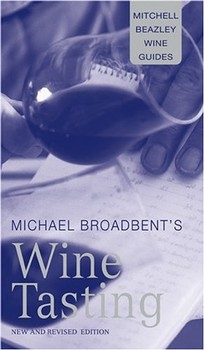
It's not so much knowing the way to taste wine, you learn in Broadbent's tiny tome, but the reasoning behind it. He says right up front, in his Preface:
... there is a reason for every color, smell, and taste. Every facet of a wine's effect on our senses, particularly sight, smell, and taste, is meaningful. Exploring and understanding these facets help us to appreciate wine more fully.
Translation: The most important thing you can do when tasting any wine is to pay attention to everything — how it looks, smells, feels, etc. — without glossing over any detail, big or small. This is hard even for wine professionals because it's human nature to do that. You meet a person, for instance, and you find yourself focusing on his mustache, the color of or acne on his skin, the shape of his shoes or fingernails, whatever you personally obsess over. You do that, and you overlook everything else — his height or weight, the genuine look in his eyes, his personality, wit, convictions, and on and on. We all fall into that trap, which is why it's so easy to look at just one or two parts of wine in your glass and totally ignore the rest, thereby missing out on some really nice (or sometimes awful) stuff.
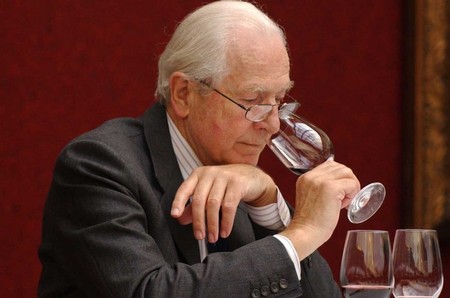
The late, great Michael Broadbent MW (image courtesy of Decanter)
Therefore, if you want to fully appreciate any wine, you follow Broadbent's step #1: Examine the whole thing.
Step #2 for Broadbent, or at least the other important step that 99% of wine lovers probably miss: Remember that you may taste wine with your eyes, nose, and mouth, but you are really tasting wine with your mind. This is part of wine tasting that Broadbent calls "Practice, Memory, and Notes." He writes:
Although wine can be consumed with enjoyment without a lot of fuss and nonsense, reasoned judgment of the finer wines must be based on knowledge, and this can be acquired by the sort of practice in tasting that will help a vinous memory — a memory that will hold in store the great touchstones, the standard norms and the exceptions to the rule.
My translation: We taste everything — foods, drinks, etc. — based upon what we remember about our previous experiences of everything we've tasted before. So in order to appreciate wine, wine, you have to be able to remember wines you've tasted before. Even the process of tasting wine — say, the creamy fullness of a Chardonnay, the herby bearishness of a Cabernet Sauvignon, the leather gloves scent and texture of a Spanish Tempranillo, etc. — is steeped in how our memory banks define our experience, be it the freshness and softness of cream, the vegetal scent of green herbs, the explosion of sweet/tart flavor of a wild berry plucked from a bush, or the pungent smell and feel of a new leather glove.
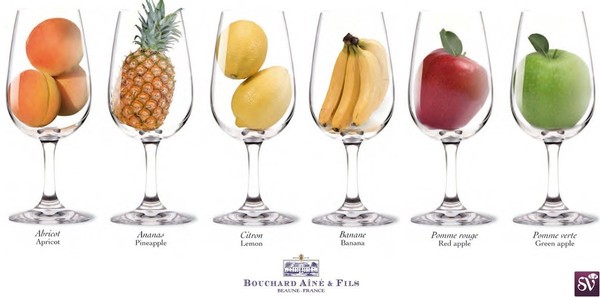
Common fruit qualities suggested in wines (image courtesy of Bouchard Aîné & Fils)
Therefore, yes, you taste wine with your senses, but you appreciate it, for good or bad, with your brain — particularly, your memory banks.
This is why it's important to have some kind of informed (or "reasoned," as Broadbent aptly puts it) conception of what you're tasting. Especially for contemporary wines that may be trying to address your senses with things that are a little different than what you've experienced before or to which you've become accustomed.
Wines, after all, have always been a little bit like fashion. Styles come and go, or evolve over time. Just like you: 20 years ago you may have preferred the lush, fruity taste of White Zinfandel, and then maybe "graduated" to creamy Chardonnay, blustery Cabernets and Zinfandels, refined, fragrant Pinot noirs, or "oddball" imports from Greece or South Africa.
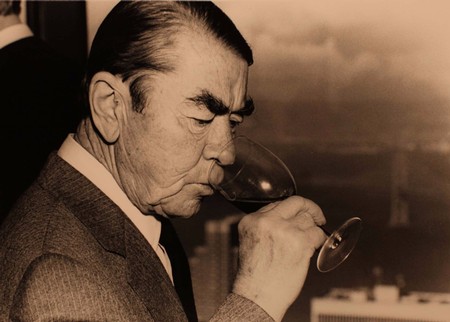
André Tchlistcheff, the pioneering California winemaker of Russian descent, once described a red wine as having “the sensual aroma of a woman’s leather glove with a hint of her perfume and personal scent” (image courtesy of Weinkrake)
Commercial wines change in any number of ways: Many of them these days are getting lighter in alcohol, sharper in acidity, maybe less oaky or more oaky, or more earthy and less fruity — sensory qualities reflecting evolutions in consumer tastes, winemakers' artistic sensibilities, or just the shrewd decisions of marketing wags behind brands.
So here are some expanded definitions of wine terms that pertain to what you taste on the palate, specifically in terms of the way many commercial wines are made these days, and which may give you the intelligence to help you build, as Broadbent put it, your all-important "vinous memory"...

Professional Lodi Zinfandel tasting
Body
The weight of a wine's sensory impression on the palate is primarily related to alcohol by volume (wines 8% to 11% in alcohol tend to be very light or delicate, medium-bodied at 12-13% alcohol, and fuller bodied at 14-16% alcohol). Other factors contributing to a sense of body may include phenolic content or tannin levels, and residual sugar in the case of sweet wines.
Traditionally, it is said that wines from warm to hot climates tend to be fuller-bodied than wines from cold to cool climates. In the modern era, however, warm climate regions on the West Coast, Lodi, South Africa, or South Australia have been known to produce lighter-bodied wines simply by dint of picking at lower Brix (example: picking at 20° to 22° Brix to produce wines finishing below 12.5% alcohol) — a practice requiring focused attention on farming for fruit maturation at lower sugars.
By the same token, West Coast regions known for cooler-than-average climate have been known to produce very full-bodied wines almost as a rule because certain factors — such as temperature, wind, or extreme diurnal swings — often do not allow acid levels to come into balance with optimal fruit maturation until grapes reach higher sugar levels (i.e., 25° Brix or more), resulting in alcohols exceeding 14%. Yet in both cases, distinctive, high-quality wines can be produced. Ergo: a region's average climate classification does not automatically correlate with the old, simplified assumption that lighter-bodied wines are produced in cooler climates and fuller-bodied wines in hotter climates.

Markus Niggli, a Swiss-born winemaker who has carved his reputation for crafting Lodi-grown white wines that are as light, crisp, and minerally as any whites grown in much cooler climate regions of the world
Alcohol by volume (i.e., ABV)
Level of alcohol or ethanol required by law to be stated on bottle labels. While bottle ABV gives the consumer an idea of a wine's sense of body or fullness (table wines that are more than 14% in alcohol tend to be fuller, and wines less than 13% tend to be lighter), this is still an inexact way to determine body because federal law allows wineries 1.5% plus-or-minus leeway in wines up to 14% ABV. For wines above 14%, the leeway is 1%. This means a wine that is actually 15.5% in alcohol may say just 14.5% on the label, or a wine that is 14% in alcohol may say just 12.5% on the label. Most wineries, in fact, routinely take full advantage of this variance in order to project a semblance of consistency in their bottlings from year to year, whereas just a minority of wineries strive for actual accuracy.
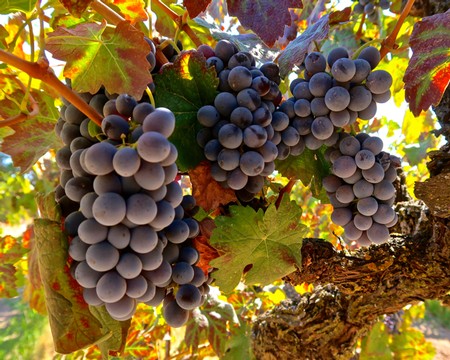
Lodi grew Barbera, which produces a naturally high acid red wine of fairly full body (in the 14% ABV range)
Acidity in wine
Acids are a natural component of grapes and resulting wines. Its palate sensation in finished wines can be described as fresh, tart, sour, lively, or zesty, and its presence can brighten aromatic qualities with suggestions of citrus fruit. Acidity is measured as titratable acidity (i.e., TA, the sum of all the organic acids in juice or wine), although the actual strength of acidity is measured in terms of pH (the lower the pH the higher the acidity in wine). The major acids in wine are tartaric, malic, lactic, and (in tiny percentages) citric.
Tannin
Class of biomolecule found primarily in seeds of grapes, but also in skins and stems, responsible for the astringent (i.e., a drying feeling) and sometimes bitter sensations that may contribute to a sense of fullness in wines as well as antioxidant properties enhancing a wine's ability to improve over time.
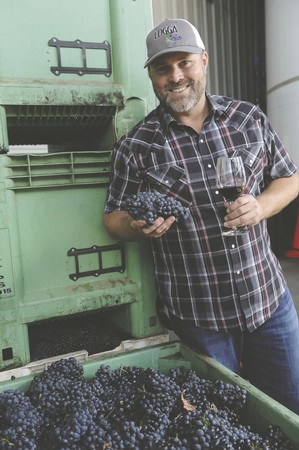
Adam Mettler, an award-winning native Lodi winemaker who has carved a reputation for full-bodied, deeply pigmented red wines crafted for both Michael David Winery and his own family's Mettler Family Vineyards
Phenolic content in wine
Phenolic compounds (natural phenol and polyphenols) found mainly in skins, stems, and seeds of grapes, including anthocyanins (pigments) and tannins — the latter responsible for the astringent and sometimes bitter sensations in wines that may contribute to the sense of fullness in wines as well as antioxidant properties enhancing the ability to improve over time. Winemaking practices such as "maceration" or "cold soak" are customarily practiced to enhance the feel of phenolic content in wine without increasing bitterness or astringency, as does extended oak aging (the latter, also adding vanillin, toasted or charred sensations).
Malolactic fermentation (i.e., secondary fermentation)
A bacterial fermentation, different from primary (alcohol) fermentation, takes place in wine whereby malic acid is converted to lactic acid, thus imparting rounder, softer qualities as well as an additional complexity (both textural and aromatic) to a wine. Although malolactic fermentation occurs naturally in wines, winemakers typically prefer to control the timing and efficiency of the process by inoculating with lactic acid bacteria, following or frequently at the same time as primary fermentation. When winemakers endeavor to retain a sharper acid balance, another common practice is to suppress malolactic fermentation by early pressing or racking, by maintaining sufficient sulfur dioxide levels, by filtration, or by keeping temperatures below 57° F.

Three macro bins of 2020 Lodi Zinfandel in McCay Cellars have just come out of a 1-week cold soak, and just beginning to warm up and start a slow native yeast fermentation
Cold soak
A pre-fermentation winemaking process that first came into vogue during the 1970s and 1980s in Burgundy, France for the production of Pinot noir-based reds, and today has become standard practice all over the world for not just Pinot noir but also for grapes such as Zinfandel, Cinsaut or Grenache which, like Pinot noir, tend to be moderate in phenolic content (primarily tannin and anthocyanin or color).
As the name of the process implies, just-harvested grapes are kept or placed in a vat to "soak" for a period of usually 3 to 10 days at temperatures somewhere between 40° to 59° F. in either a temperature-controlled tank, with the use of dry ice or in a cold room. This keeps fermentation from starting and enables an aqueous (i.e., water) extraction of color, aromas, and flavors without tannin since it is during the alcohol fermentation process that tannin molecules are extracted. The desired result is a deeper color, richer fruit qualities, rounder tannin, and enhanced mouth-feel. For vintners planning on native yeast fermentation, this period of time also allows indigenous yeasts to get established prior to fermentation.
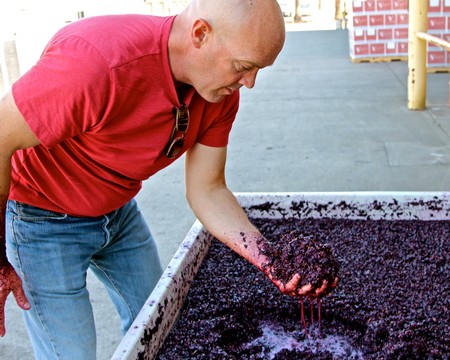
Lodi's Mike McCay becoming one with his fermenting Zinfandel
Following a cold soak, grapes are allowed to warm up to initiate fermentation, usually with a gentle punch-down. Variables include the choice to cold soak grapes as whole clusters, as destemmed berries, or a combination of both; whether to add sulfur dioxide to inhibit undesirable microbial activity, or the options of using inert gas to prevent oxidation and adding enzymes to enhance extraction. These decisions are typically based upon vintage conditions, qualities of each vineyard or block, and of course, winemaker or brand styles.
It should be noted that during the 1980s and 1990s, one of the controversies associated with pre-fermentation cold soaking in Burgundy was that the practice enhanced fruit intensity at the expense of sensory delineation and expression of individual vineyard terroir. But most of this criticism was directed at examples of red Burgundy where extreme cold maceration was practiced (as long as 15 to 25 days); and these wines were often made from fruit picked at higher than typical sugars, resulting in fuller alcohol wines that were often aged in higher percentages of new oak barrels. This resulted in what one author called a "Cabernet-zation of Burgundy" — wines certain critics often described as "hedonistic," while awarding them higher point scores. Since those times even the most avid proponents of cold soaking have reined in those excesses; and there is now a consensus that rather than blurring terroir, cold soaking enhances both fruit and vineyard expressions.

Blind tasting of Lodi Zinfandels (image courtesy of Provence Winezine)
Balance
A wine can be described as balanced when all its sensory qualities are in harmony, without excess of one element or another. That is to say: Acidity is balanced when a wine is neither too puckery nor so soft that it lacks freshness or crispness. Tannin is balanced when the wine is not unpleasantly bitter or astringent. The body is in balance when alcohol does not taste harsh or hot. Aromatic qualities — such as oak, herbiness, or fruitiness — are all subjective to a beholder's sense of balance.
After that, all bets are off, because what may seem like a balanced wine to one person may be rough and excessive to another person, or weak and wimpy to still another person. There is no accounting for taste, even among respected critics, but Vive la différence. What is unacceptable is the assumption that universal standards even exist.
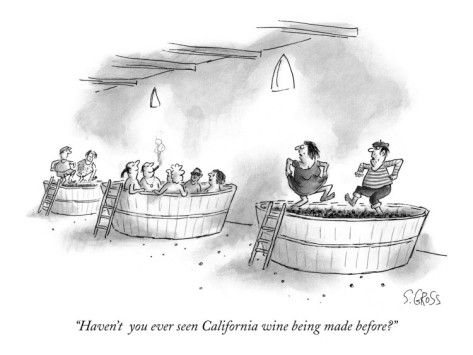
Classic, old New Yorker cartoon which sheds light on the fact that not all wines are made with the same sensibilities — and, in fact, are meant to be "different," and thus appreciated differently
In 2011, for instance, a group of American wine industry professionals started an informal movement called In Pursuit of Balance (IPOB) to draw attention away from fuller-bodied, intense styles of wine (i.e., wines higher in alcohol and ripe fruit qualities), based upon the inference that lighter, more subtle wines are more "balanced." The intention was laudable, but problematic in a number of ways; including 1) many wines by dint of origin find their most compelling balance when they are full-bodied and intense, 2) lightness and subtlety are often excuses for wines made in erroneous ways, are grown in wrong places or are just plain boring, 3) in many vintages Mother Nature, not vintners, dictates that full-bodied, intense wines be made, 4) there are just as many food affinities for fuller-bodied wines as there are for lighter wines, and 5) many consumers prefer big, blustery wines.
Ergo: Singular definitions of balance are simply not applicable to all wines from every place, even when made from the same grapes (the latter factor, a reflection of the American obsession with varietal character). Therefore, neither alcohol level nor ripeness of fruitiness can define "balance" — especially since the qualities appreciated in the world's most interesting wines are determined more by their sense of place than the expectations that anyone might place upon them.

Lodi wine lovers